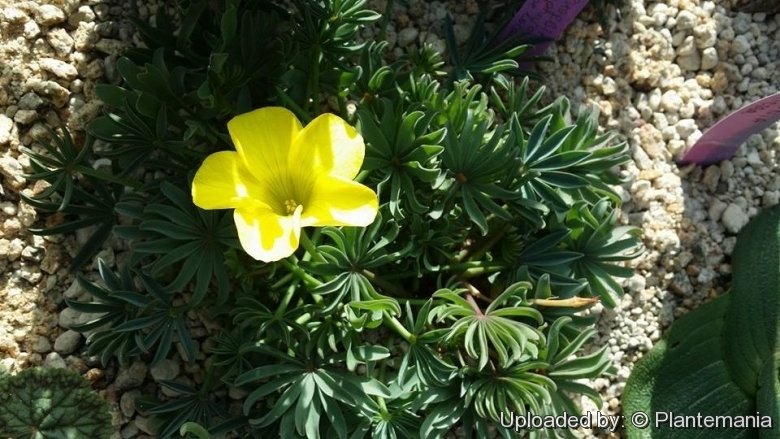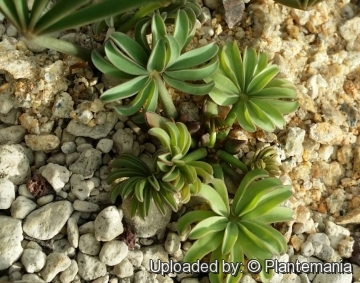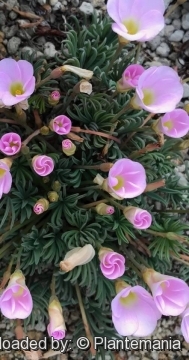Accepted Scientific Name: Oxalis flava L.
Sp. Pl. 433 1753. L.

Acetosella flava (Oxalis flava) Photo by: © Plantemania
The distinguishing characteristic of this species is the leaves, which appear together like the fingers of a hand.
Origin and Habitat: Namaqualand to the southern Cape, Republic of South Africa.
Habitat and ecology: Oxalis flavaSN|33474]]SN|33474]] grows on flats and lower slopes, often on sand. Reports from many parts of South Australia indicate that this species is spreading rapidly from cemeteries and gardens. It has already formed open paddock infestations near Port Lincoln.
Synonyms:
See all synonyms of Oxalis flava
back
Accepted name in llifle Database:Oxalis flava L.Sp. Pl. 433 1753.Synonymy: 8
back
Common Names include:
ENGLISH: Narrow finger-leaved Cape Wood-sorrel, Yellow Wood Sorrel, Yellow Oxalis, Soursob
AFRIKAANS (Afrikaans): Bobbejaanuintjie, Bobbejaansuring, Vingersuring
Description: Oxalis flavaSN|33474]]SN|33474]] is a stemless perennial with the leaves in a tuft at soil level often not fully expanded at flowering, hairless, leathery and greyish, with large brown stipules, divided into 2-12 narrow to elliptical, folded leaflets. When the leaflets are closed the foliage has a very distinct appearance from that which it has when these unfold. It bears large trumpet-shaped flowers of white, yellow, or sometimes pale lilac, only one on each stalk. This species is autumn blooming. Oxalis flavaSN|33474]]SN|33474]] is very variable with many different varieties or forms often referred as a species-complex.
Bulb: Bulb ovate, about 1-3 cm broad ovate consisting of a smooth, crustaceously membranous covering and a white kernel of the consistence of an almond. When young, the bulbs of Oxalis flavaSN|33474]]SN|33474]] are pink and round.
Stem: Very short mostly underground or more or less elevated above the ground, scaly.
Leaves: 5 or more terminal in a tuft at soil level, palmately arranged, leathery, slightly succulent, smooth and greyish-green, with large brown stipules. Petiole 2.5-5 cm long, thick, compressed, terete, mostly reddish, 2.5-10 cm long, channelled. Leaflets (2-)5-9(-12), oblong-linear, linear to elliptical, channelled-connivent, each at first folded lengthwise, then expanded, obtuse or acute, with a small point, minutely dotted paler at the under side, 1.5-5 cm long about 2-6 mm broad.
Inflorescences: Peduncles several, slender, equalling or excelling the petioles, jointed at the base, one-flowered, having two small bractes placed alternately near its top.
Flowers: Flower single on a the scape deep or yellow, white, rosy-pink, lilac or purple on the outer margin. Sepals equal, oblong, acute or obtuse, often callous-tipped, glabrous or ciliate, 4–5 times shorter than the corolla. Corolla. Filaments connected at the base, inner ones denticulate, sprinkled with short capitate hairs, from which the small teeth are free: outer ones thickly covered by the same kind of pubescence as the inner. Styles very short pubescent underneath smooth above
Bibliography: Major references and further lectures
1) W. Sonder “Flora Capensis”, Vol 1, 1894
2) Sydenham Teast Edwards, John Lindley “The Botanical register: consisting of coloured figures of exotic plants”, Volume 2 1816
3) John Manning, Colin Paterson-Jones “Field Guide to Fynbos” Struik, 2007
4) Journal of Agriculture, South Australia, Volume 70 Department of Agriculture, 1966
5) Pauline Bohnen “Flowering plants of the Southern Cape” Still Bay Trust, 1986
6) Pacific Bulb Society “Oxalis flava” web: <http://www.pacificbulbsociety.org/pbswiki/index.php/Oxalis_flava>
 Acetosella flava (Oxalis flava) Photo by: © Plantemania
Acetosella flava (Oxalis flava) Photo by: © Plantemania Oxalis flava a thin leafed form. (Oxalis flava) Photo by: © Plantemania
Oxalis flava a thin leafed form. (Oxalis flava) Photo by: © Plantemania Oxalis flava pink flowered form. (Oxalis flava) Photo by: © Plantemania
Oxalis flava pink flowered form. (Oxalis flava) Photo by: © Plantemania Acetosella flava (Oxalis flava) Photo by: © Plantemania
Acetosella flava (Oxalis flava) Photo by: © PlantemaniaCultivation and Propagation: This is a winter/spring-grower, but can grow all year. It responds well to cultivation, making a superb, well-packed display of flowers in a pot or pan, under frost-free or alpine house conditions, in a loam-based compost.
Reproduction: Seeds. These are produced in the typical explosive capsules of this genus that ensures the seeds are dispersed up to a few metres from the parent.















